Guest Column: The Lamarticle ... by Brendan
Lamar Jackson is worth the 3rd pick in the draft
For the past 2 decades the Jets have seemingly lacked two things: a consistent offensive identity, one that defines the players you bring in and the style you play, the mentality you attack with; and...cool. The Jets aren’t cool. They haven’t been cool for decades. They were loud, brash and unavoidable under Rex…but they weren’t cool. People detested those teams. They were flashy in the 80s, but they weren’t really cool then, either, despite having some very cool players. And this trend hasn’t been due to a lack of star power, as the Jets have cycled through studs on both sides of the ball, from the executive suite down to the sidelines. The common denominator in all of this has been the Jets lacking a jaw-dropping, undeniable talent at QB. They lacked the player whose greatness could not be refuted by talent evaluators and analysts and fans and begrudging rivals and old pros and future pros and media types. They’ve had great players at nearly every other position on a football field, but not since Joe Willie Namath was last gimping around the Shea Stadium infield have the Jets had a QB that defined both their style of offense and carried the swagger to buoy an entire team. Perceptions are real, and the Jets’ have not had a favorable one in a long time. Securing a QB that kids want to emulate and that sports networks and social media platforms want to create content about is the type of move that changes those perceptions.
Lamar Jackson is that type of player. He’s a once in a generation running talent, the most impressive runner at the position since Vick, on the same God Tier that Rookie RGIII was on. And while his legs are a big part of the reason he is special, make no mistake…Jackson has the potential to be every bit as good of a passer as any of top QB prospects in this class. In 2015, Jackson was a runner with a hitch-and-throw motion who rarely made it past his first read. In 2016 Jackson won the Heisman based as much on his big plays through the air as it was on his legs. Equipped with a smoother throwing motion and an improving understanding of the offense, Jackson was able to mix in multiple-read concepts on a weekly basis. And in 2017 it seemed to finally come together for Jackson as a passer, with Bobby Petrino having to tailor his system less and less to Jackson’s specifics and Jackson becoming a horizontal scrambler rather than a runner. When the Jets are on the board at 3, Macc should just ignore the noise and draft the most dynamic pocket passer in the draft class, and yes that is one Lamar Demeatrice Jackson.
Throwing Motion
The evolution of Jackson’s ability as a pocket passer is directly tied to the improvements he’s made to his throwing motion. As a true freshman in 2015, Jackson had a noticeable dip-and-hitch motion where he would “show” the ball (hold it behind his ear and away from his body before beginning his forward motion). It wasn’t quite a full windmill, but the hitch coupled with his showing the ball would be catnip to pass rushers in the NFL. Over the next two years Jackson focused on ball position and shortening his motion and he now has arguably the quickest release in the entire draft class. While Jackson has gotten better at eliminating his hitch, if a play drags on he will drop his hands and the ball level will sink, so you’ll see him raise both hands back up to set and throw. This could create bigger issues at the pro level, but Jackson is so good at sliding around pressure that as long as he’s protecting the ball with both hands he should be okay.
2015:

2017:
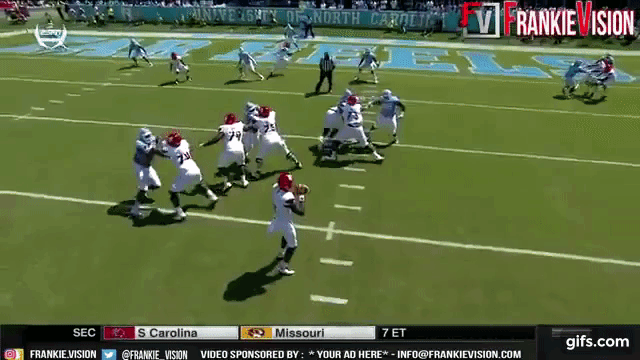
While the motion itself has improved to the point that it is a strength, the footwork…has not. Jackson’s feet are inconsistent, but in many cases the inconsistency is overstated. The biggest inconsistency Jackson shows is not bringing his back foot through and completing his follow-through. This translates up to bad hip alignment (he won’t be “facing” his target) and his passes can sail or be otherwise off-target. On short passes these will typically still be catchable, but they also eliminate the chance for significant YAC gains. These plays are easy opportunities for yards that will continue to be there for Jackson at the NFL level as teams prepare for his legs and dedicate some kind of spy or bracketing to box him in. Jackson must improve the consistency of his footwork on easy throws where he’s not rushing to maximize the benefit these plays will bring the offense. The one thing that is most unique about Jackson’s throwing motion is his weight transfer/balance. Typically, QB’s push off their back foot, transfer to the front, follow through and land. Similar to a “front foot hitter” in baseball (made famous by Robert Clemente), Jackson is a “front foot” thrower. His back foot is more rudder than engine. Jackson has a very similar throwing motion and follow through to…wait for it…Tom Brady. Seriously, look:

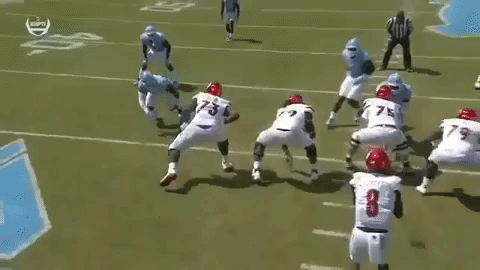
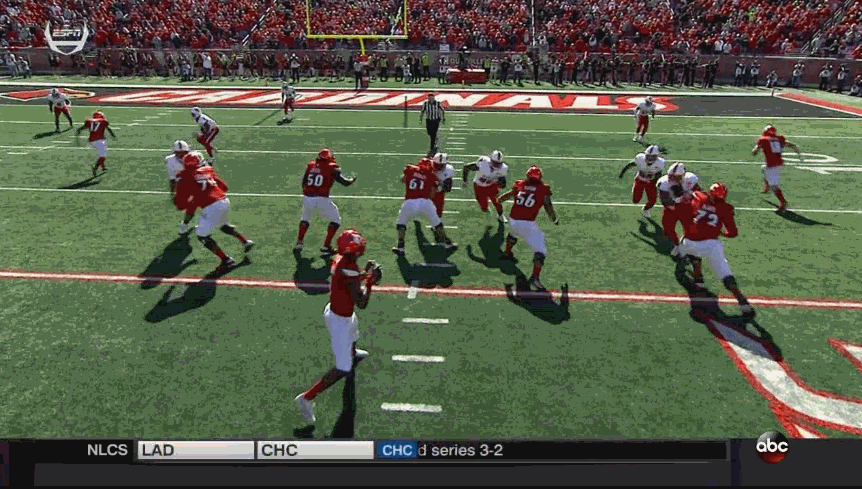
On plays where Jackson dials up the power, it puts a lot of stress on his front knee. But because he is a quick-twitch athlete, Jackson is able to generate more strength with quicker, more efficient movements. Jackson doesn’t need to have a big wind-up or a big step in order to generate power, his muscles are tuned to be able to do this at will. This is an important detail to understand when evaluating Jackson’s QB prospects at the next level.
It’s not all roses and sunshine:
For each section I’ll make a point to highlight some of the concerns I have for Jackson. For his throwing motion, while he has eliminated most of the instances of “showing” the ball, he still sometimes goes full-sidearm and cocks the ball out a bit. He almost always does it in a clean pocket and for a WR crossing the middle of the field, so this should be correctable, but it is something to watch for. If NFL pass rushers get the memo that they can swipe at Jackson even in a clean pocket and he might leave it on a platter for them, that’s a potential nightmare. We’ll dive into this more in the next section, but this is again an area that is alleviated by Jackson’s ability to feel and slide around pressure.
Regarding his feet, I am far less concerned about this than most, mainly because Jackson doesn’t have a particularly strong push-off. His power comes from whipping his hips through and putting all his weight on his plant foot. This does raise a mild concern (more than other QB’s) about him getting a Brady knee tear if someone falls into him. His entire body is balancing on a tense knee joint, it’s something to be cognizant of. For Jackson it is all about consistency with the footwork. If he throws with his feet under him he’s as accurate as any non-Mayfield QB in the class.
Pocket Awareness/Play Under Pressure
Jackson has a good natural feel for pressure and due to his elite athleticism he’s capable of creating missed tackles in the backfield on a consistent basis. Quick-twitch movement and jukes in the pocket are weekly highlights, and not in the Chaddy P way, either (RIP London Fletcher). One of the biggest points to make here is that Jackson is NOT a scrambler who looks to run. Early on in his career, as with many QB’s with elite running ability, Jackson would be quick to tuck it and run when under pressure. In fact, it was such a strong instinct that Jackson would oftentimes tuck it at the first sight of a running lane. Jackson was feeling pressure that wasn’t there and would fall back on the tool that was most natural to him. As Jackson has grown more comfortable in an NFL-style offense, and grown more comfortable with his ability to find big plays through the air, he has become a horizontal scrambler instead of a vertical one. He’s prioritized using his legs to buy time rather than create first downs with them. As our friends at Pro Football Focus put in tweetable form for us, the vast majority of Jackson’s rushing yards come from designed runs (in fact, 73% of Jackson’s rushing yards in his career at Louisville came on designed runs). This has set him up well for a transition to the modern NFL, where teams are much less reluctant to embrace a QB’s running ability, and also where horizontal scrambling ability is the best way to unlock the big play.

And now...some gifs. I picked these three plays because they all exhibit something unique/special about Jackson’s play under pressure.
Gifs:
(a) 
This is a play the majority of QB’s are rushing their throw on, if not being sacked outright by the streaking backside rusher. Note how Jackson sells the fake, which holds the DT in the pocket, and then quickly identifies the frontside edge rusher, altering the path of his rollout immediately after whipping his head around. Because of Jackson’s athleticism, he simply sidesteps to buy the moment he needs to get the pass out and then he drops it over a LBer in the flat for 6. Also note that the LBer who Jackson slots the pass over has to stay tight to the LOS because Jackson is a threat to run in that situation. This exhibits how his athleticism makes attacking him difficult.
(b) 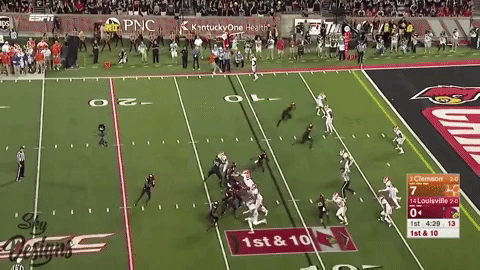
This gif shows a complete OL breakdown where Jackson faces immediate interior pressure. Jackson is not able to work through his reads and is now in Freelance mode, which happens to be an area where Jackson excels and rarely displays signs of panic. Reduced to half the field, Jackson forgoes chances to run (Jackson could cut it back after initially eluding to find the lane in the middle of the field, or just dip to the sideline and take a no gain on 1st down), and instead keeps his eyes downfield. At the time he throws it there are FIVE defenders in the vicinity, with a 6th in the flat guarding nobody. That is SIX total defenders dedicated to Jackson, which indicates every WR is in a 1v1. Simply by being athletic he’s creating mismatches, and here he is able to locate the ball where only his WR can reach it.

By looking at the alternate angle you can better pick up on 2 details. First, the subtle juke step buys Jackson enough time to slip out to his right and elude the DT. If he just stands and runs, the DT sends his full momentum in that same direction and Jackson is cooked. Second, once he’s out of the pocket, Jackson’s eyes do not once look down to tuck it. He is a pure passer from start to finish on this play and it’s a glimpse into why Jackson has levels to his play that don’t exist for other QB’s.
(c) 
“But Brendan, all these are showing teams attacking him, surely there are some teams who realized that was a bad idea!” I got you, fellow Jets fans. Here is what happens when Jackson gets /too/ much time, though. Look at the oceans of green space he’s able to play with. If you rush 3 on Jackson, odds are your DB’s get crossed up before he does. And once you give the receivers time to work downfield and get backs facing Jackson, it opens up running lanes all across the field. I also included this gif because it shows that Jackson has a rare ability to throw his fastball while rolling to his off hand. Because of the aforementioned front-foot passing technique, he generates a snap effect and the ball almost explodes out of his hand.
Jackson is also a very good and accomplished passer under pressure. His line when facing pressure was very strong: an adjusted completion of 63.7%, 927 yards, 7.7 Y/A and 8 TD’s to just 1 interception. Out of the entire draft class, Jackson posted the third highest passing grade under pressure (behind only Baker Mayfield and Mason Rudolph). And when compared with those players, Jackson faced pressure on a much higher % of drop-backs (35.8% for Jackson, 27.3% for Mayfield, 23.3% for Rudolph), while also being saddled with the highest drop rate (8.4% vs. 7.4% vs. 6.3%). With improved talent surrounding him, Jackson stands to make huge strides in this area in the pros, as he is consistently capable of finding teammates and making plays to get them the ball.
It’s not all roses and sunshine:
The main negative in this area is that Jackson can get too cute in his scrambling. It happens probably once a game, and the best thing for an NFL team to teach him is to take the easy 5 yards and slide, or in a real bad spot just go down. As you’ll see in the gif below, there is more than one chance for Jackson to take off for a positive play on the ground. Instead, he continues running around trying to find the Big Play and ends up on the ground behind the line of scrimmage. At times, Jackson appeared too invested in becoming a pure-passer and it seemed like he would shy away from using his most special natural ability.

NFL Readiness/QB IQ
There have been quite a few, um, misinformed takes on the type of offense Jackson played in at Louisville and the type of QB he is. Jackson comes from an NFL-style Erhardt-Perkins offense, which Jets fans should be extremely familiar with since it’s the basis for the offense that Brady has been using to ruin our Sundays for years. A quick summary of the E-P offense that Louisville Head Coach Bobby Petrino utilizes is that it is a “concept-style” offense where plays are designed to be run regardless of the personnel. You cycle through formations, groupings, etc. but the play itself is always the same. It’s how the Patriots are capable of running the same play 15 times in a row by just rotating personnel groupings in and out. It will create different defensive matchups for the same route and the QB can choose the matchup to attack and set up accordingly. Someone well-versed and comfortable in this style of offense can be a pain to gameplan for. If Jackson goes to a team with a similar style of offense, he could be a Day 1 starter (with typical rookie struggles). This is probably where Jackson’s less-than-stellar Wonderlic score of 13 should be mentioned. Jackson having the full confidence of a former NFL head coach is more proof that Jackson can handle an NFL playbook than him having a bad day doing logic problems, but it is fair to criticize he and his mother’s belief that an agent was unnecessary. It would have been vital to clearing up a lot of the miscommunications between Team Jackson and NFL teams, and it would have made prep for the Wonderlic more of a priority.
Jackson showed up as a true freshman who would single-read and run. In some cases, he could drop off the first read if the 2nd read was on the same side of the field, but that’s still essentially one-read QB play. He was not running the E-P offense, he was running a sub package that was a more dressed up Wildcat. In 2016 his ability to get to the 2nd read was better, but still inconsistent. In 2017 Jackson was making it to his third read on a consistent basis. Each year Jackson continues to focus and improve and there is no indication that will change.

On the play above, Jackson makes two reads to his left, resets and drops one in the bucket to the opposite sideline. This is a play he was physically incapable of in 2015, and that had a minimal chance of success in 2016. In 3 short years Jackson has gone from a runner with a good arm to a full pocket passer, capable of doing everything necessary to succeed as a passer from the pocket, only.
Another one of Jackson’s targeted areas of improvement was anticipation. This year, Jackson started throwing WR’s open, or leading them with passes into YAC yards they otherwise wouldn’t have seen. As was mentioned earlier, Jackson has shown a tendency to get sloppy with his footwork and his mechanics on quick & easy passes, and this ties into that. When the mechanics break down, so does ball location, and thus so does the YAC opportunities presented to his playmakers. It seems Jackson started to get a handle on this at some point in late 2016 and then in 2017 he was making a concerted effort to locate the ball up and ahead of WR’s so they could track and run under it.
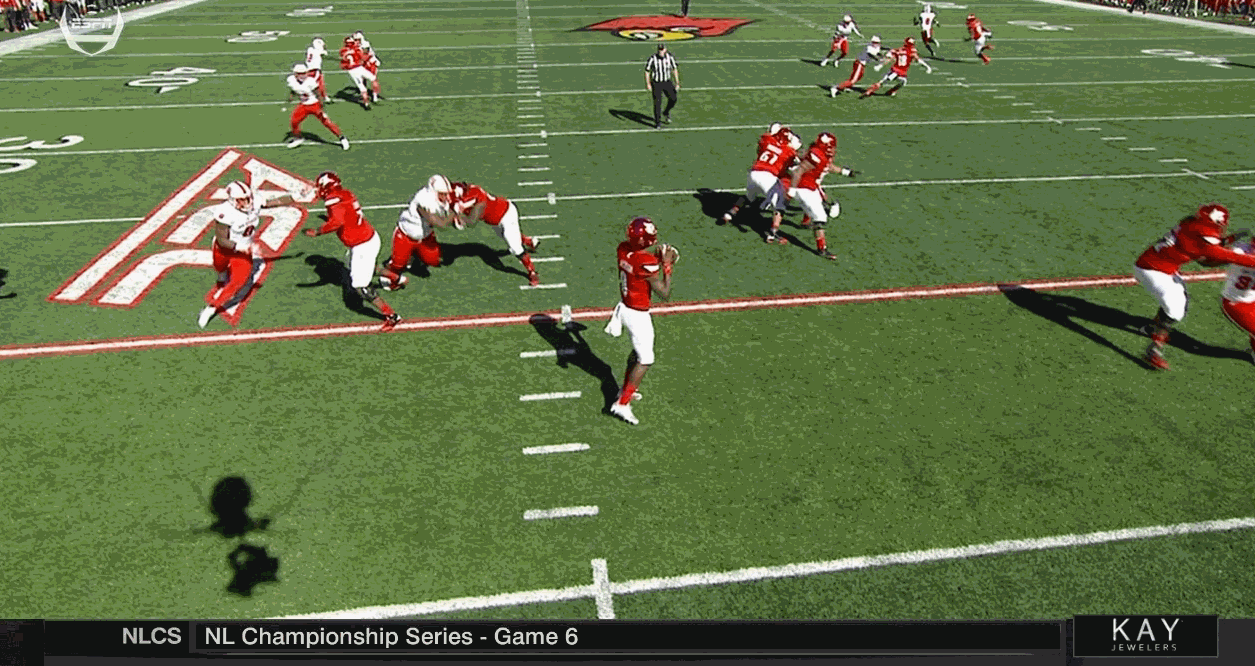

If Jackson were to start right away in the NFL he would flash the ability to confound defenses, but he would also have intense struggles with the underneath coverage games NFL teams play. It is by far his biggest weakness as a passer, particularly when LBers fake a blitz, then drop off the line of scrimmage in the chaos at the snap. Jackson has shown an inability to consistently pick up and mark these linebackers, and has thrown a number of passes that will be picked off (or nearly so) in the NFL. Similarly, he will sometimes misread a zone/man combo coverage and not locate the ball in an area where the defender can’t get to it. Below are examples of each. Defensive coaches in the NFL will key on these issues and relentlessly try to exploit them, so if Jackson were to start immediately he would need to make big strides in training camp in order to get up to speed here.
Also, please note: Jackson is not small. He’s not too small to play QB, he’s not too small to take big hits, he’s not too small to run it in the NFL and he’s not too small to embarrass good defenders. Here are some gifs of him getting absolutely bludgeoned that he came back from:
/cdn.vox-cdn.com/uploads/chorus_asset/file/9405105/Lamar2.gif)

Comparison With Draft Class

If I were to remove the names, the only indication for which one is clearly Jackson is the 95.1 run grade. Outside of that, Jackson ranks in the top 3 in every metric, save for passing grade where he is a half point out. He doesn’t do his work behind the LOS, he doesn’t throw up 50/50 balls all day, the majority of his passing is in the intermediate, he has a comparable-or-better aComp% and he has exceptional TO #’s. The argument can be made that based purely on stats and grading, Jackson should be in the conversation with this top group. For everyone. For every team, analyst, etc. Instead we’re discussing...wide receiver transitions. I can only give these narratives the heartiest of FOH’s.
Jets Fit?
But all this begs the question: how does Jackson fit in with the Jets and their future plans? Jeremy Bates subscribes to the Sean McVey Common Sense School of Offensive Philosophy, with such novel concepts as “put players in position to do what they do best” and “don’t smash that square peg into a round hole.” If Jackson rolling out creates situations where defenders have to commit or give up a quick and easy 5 yards, that’s something Bates will most likely be willing to exploit. Finding a weakness and going after it, and being prepared for the adjustments to the initial problem will create for the opponent. Jackson is a series of Choose Your Destiny novels, each play can lead a defense into den of warlocks if they choose unwisely. Jackson coming from an NFL-style offense with similar concepts to what Bates will run means the intellectual carry-over should benefit Jackson, and he should have no issues mastering his playbook or continuing to develop his reading of defenses. I actually put the Jets on the shortlist of best potential landing spots for Jackson thanks to Bates’ (assumed) style of managing talent and the style he’s supposedly employing. And not to mention, the Jets currently employ a few very exciting players who Jackson would be afforded a chance to grow with, guys like Robby Anderson and Quincy Enunwa, and possibly growing to include Terrelle Pryor, Chad Hansen or ArDarius Stewart, plus Jordan Leggett and whoever is coming in with this draft class.
Lamar Jackson is a once in a generation talent. Josh Rosen isn’t. Baker Mayfield isn’t. Sam Darnold or Josh Allen or Mason Rudolph aren’t. They’re all unique, they all have potential and are all (save for Allen) already good prospects. And Jackson possesses the ability to be as good as any of them as a pocket passer. That being said, I don’t expect him to be the best pocket passer in the group. But…here’s the thing: I don’t need him to be. Jackson can be a pocket passer who, if you sleep on him or forget to spy him for just a single play, possesses the ability to rip off 80 yards before you have a chance to turn around. There are things he is capable of that change the paradigm of defending the QB. If he is just above average as a passer (or slightly above average, or even average) but is also running and providing game breaking plays with his feet, that’s still a winning, potentially special player.
The Jets should embrace the modernity of Jackson’s game, embrace the possibility that a new offense with a new cornerstone piece can bring and take an NFL-capable passer with world class athleticism. The Jets could be cool again, and wouldn’t that be something?